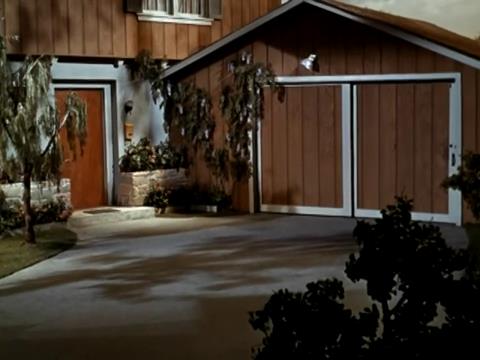The
30-Foot Bride of Candy Rock
Dorothy Provine, in short, represented in Wonderama and Mattascope as a
Baudelairean giantess. She sweeps the city with water from a tower and hurls
the lid like a discus, where it lands is Fellini’s “Le tentazioni
del dottor Antonio” and Zito’s Invasion U.S.A.
Raven Rossiter (Gale Gordon as a banker) owns everything in Candy Rock
down to radio station KRAV and The Big R surplus store, everything except the
rubbish service operated by Artie Pinsetter (Lou Costello), its slogan is
“For Those Who Care”.
Provine is Emmy Lou, Raven’s niece. Artie has developed a machine
he calls Max (cf. a Banacek case), he’s trained it like the HAL
9000 from “one plus one equals two” up to time/space curves.
Artie helps Emmy
Lou out of her uncle’s house in a trash can, she’s ready to
“explode” if her swain doesn’t marry her. Max counsels delay,
speaking in a mechanical reflection of Artie’s voice. Emmy Lou wanders
away crossly into the depths of Dinosaur State Park, disappears in a steaming
crevice and emerges sans her clothing as the title character, because when
Raven hears she’s suddenly “big”, he sends a purblind justice
of the peace (Jimmy Conlin) to marry the pair.
Army war games
near the park are disrupted as a convoy spies the prodigy. The Pentagon sends
missiles.
Max propels the
scene back into time, Artie is a Union general pursued by Confederates, then
Napoleon fleeing Wellington’s army, finally a caveman pelted by other
cavemen with stones. Once again in the present, he flies through the air,
bumping his head on a canine satellite.
Max diminishes
the girl too far, then restores her to normal. The Pentagon acquires the gizmo,
Artie is a leading scientist, Raven no longer a maven.
The functional
surrealism thus evinced is carried out in a thousand details very rapidly,
therefore critics have not followed it. One such detail anticipates another of
Banacek’s cases, Emmy Lou under a tarp in a flatbed truck transported
like a Venus from the park to the couple’s “honeymoon cottage”,
a disused barn.
She reclines
among the hills in moonlight, wearing a silk parachute thoughtfully stitched
into a Grecian garment, or else she pokes her head through the barn roof to get
a shower from Artie’s fire hose, her appetite is Bunyanesque, milk cans
full of chocolate shakes, etc.
What Makes Auntie Freeze
My Mother the Car
A thematic reflection of “The
De-Fenders” (dir. Rod Amateau).
A trip to the
mountains for a wedding, alcohol in the radiator, a provincial constabulary,
and the bride’s speeding uncle, a bigwig who wants to know how much it
will cost to drop the bribery charge.
Cf.
nothing but Charles Rogers’ Them Thar Hills, starring Laurel and Hardy and Mae Busch.
Lights, Camera, Mother
My Mother the Car
A commercial for Stops-On-A-Dime brakes filmed in the Crabtree home
stops on the original décor after anything from French Provincial
to “Cape Cod Oriental”.
The Porter has its original brakes, though actors are set to replace
the “typical” Crabtrees.
My Son the Ventriloquist
My Mother the Car

Homage to the source and wellspring, Cocteau’s
Orpheus.
In hell without air conditioning, at a playboy client’s backyard
bash (music by The Spats) a de rigueur impromptu performance (cf.
Buńuel’s Simon of the Desert).
“Mon petit bébé,” says PZR
317, and “oy vey!”